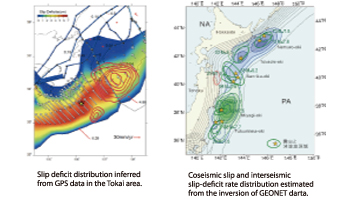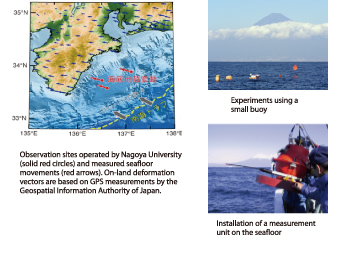Top page > Earth and Planetary Dynamics
Earth and Planetary Dynamics (Earthquake and Volcano Research Center)

Introduction
The Earth and Planetary Dynamics group is managed by the staff of the Earthquake and Volcano Research Center. The center conducts researches on earthquakes and volcanoes in geologically active areas to improve our understanding of their potential activities. The megathrust earthquake along the Nankai trough is one of our major research subject. We use a variety of methods to tackle these problems including data analysis, numerical simulation, and cutting-edge observational techniques. The staff of the research center contributes to the postgraduate education in this group. The students who are interested in the physical mechanism of earthquake and volcanic eruption are greatly welcome.
Research

Loading Process of Interplate Earthquakes
The Philippine Sea plate is subducting beneath the Tokai area, causing great earthquakes like the Tokai and the Tonankai earthquakes. We are developing an earthquake forecast method through monitoring crustal strain accumulation based on crustal deformation data such as GPS and leveling.

Seismic Monitoring
Central Japan exhibits a diverse range of seismic and volcanic activities, such as great interplate earthquakes, inland earthquakes, seismic swarms, long-period tremors and volcanic eruptions. Seismic observation is one of the approaches we use to try to understand the physical mechanisms underlying these activities.

Sea floor geodetic observation
Direct measurements of crustal deformation on the sea floor above the source area of major subduction earthquakes can make significant contributions to studies about earthquake occurrence. We have developed a system for observing seafloor crustal deformation combining the techniques of acoustic ranging with ultrasonic wave, and kinematic GPS
positioning. We succeeded in measuring the crustal deformation due to an M7 class earthquake off the Kii Peninsula on September 5, 2004. We can now measure stable crustal deformation associated with plate subduction with this observation system.

ACROSS –Accurately Controlled Routinely Operated
Signal System–
ACROSS was developed at Nagoya University and is used for producing a precisely controlled seismic signal. ACROSS is continuously operated to monitor how the propagation properties of the seismic wave change with time. This change can be related to the variation in the coupling of the fault surface and plate interface as well as magma movement beneath volcanoes.

















